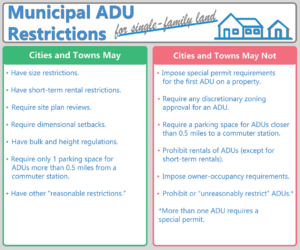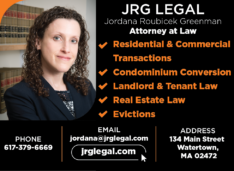2024 Bond Bill: Accessory Dwelling Units by Right, Explained
|
SECTION 7. Section 1A of chapter 40A of the General Laws, as appearing in the 2022 Official Edition, is hereby amended by striking out the definition “Accessory dwelling unit” and inserting in place thereof the following definition:-
|
|
|
“Accessory dwelling unit”, a self-contained housing unit, inclusive of sleeping, cooking and sanitary facilities on the same lot as a principal dwelling, subject to otherwise applicable dimensional and parking requirements, that: |
An ADU is a housing unit that is separate from the main house, either as a standalone structure or a totally separate part of the main house. It has a bedroom/sleeping area, a kitchen and a bathroom, and is on the same lot as the main house. This ADU must follow zoning setback and parking requirements. |
|
(i) maintains a separate entrance, either directly from the outside or through an entry hall or corridor shared with the principal dwelling sufficient to meet the requirements of the state building code for safe egress; |
The ADU must have a separate entrance. This can be directly on the outside of the building, or, for attached units, may be inside the main housing unit, as long as it meets the building code’s safety standards. |
|
(ii) is not larger in gross floor area than 1/2 the gross floor area of the principal dwelling or 900 square feet, whichever is smaller; and |
The ADU’s square footage cannot be more than half of the total square footage of the main house, or more 900 square feet, whichever is smaller. Examples: A 2,000 square foot main house cannot have an ADU that is more than 900 square feet. A 1,200 square foot main house cannot have an ADU that is more than 600 square feet. |
|
(iii) is subject to such additional restrictions as may be imposed by a municipality, including, but not limited to, additional size restrictions and restrictions or prohibitions on short-term rental, as defined in section 1 of chapter 64G; provided, however, that no municipality shall unreasonably restrict the creation or rental of an accessory dwelling unit that is not a short-term rental. |
Cities and towns can have more restrictions for ADUS, such as maximum size or whether short-term rentals (such as Airbnb) rentals are allowed. However, cities and towns cannot “unreasonably restrict” ADU construction or rental of an ADU as long as they are not short-term rentals. What counts as an “unreasonable restriction”? This is vague and leaves the statute open to interpretation and perhaps litigation from towns that do not like or want ADUs. |
|
SECTION 8. Section 3 of said chapter 40A, as so appearing, is hereby amended by adding the following paragraph:-
|
|
|
No zoning ordinance or by-law shall prohibit, unreasonably restrict or require a special permit or other discretionary zoning approval for the use of land or structures for a single accessory dwelling unit, or the rental thereof, in a single-family residential zoning district; |
ADUs in single-family zones are now permitted by right. Cities and towns cannot ban ADUs or make property owners get special permits to construct them. They also cannot have bylaws that ban property owners from renting out their ADUs. (This should remove the family-only restrictions that some municipalities have for ADUs.) However, duplex or higher zoning areas are not granted ADUs as of right. Your individual city or town may already have rules governing ADUs on these properties. |
|
provided, that the use of land or structures for such accessory dwelling unit under this paragraph may be subject to reasonable regulations, including, but not limited to, 310 CMR 15.000 et seq., if applicable, site plan review, regulations concerning dimensional setbacks and the bulk and height of structures and may be subject to restrictions and prohibitions on short-term rental, as defined in section 1 of chapter 64G. |
However, cities and towns can impose “reasonable regulations.” Property owners must adhere to regulations about their septic system’s capacity if they have a septic tank (310 CMR 15, or “Title 5”). They may need a site plan review, and may have to follow their town’s rules about setbacks, the “bulk” or “envelope” of the structure, and its height. They may also have to follow certain restrictions surrounding short-term rentals. |
|
The use of land or structures for an accessory dwelling unit under this paragraph shall not require owner occupancy of either the accessory dwelling unit or the principal dwelling; |
The owner does not need to live in the main house or the ADU to be allowed to construct or rent out an ADU. |
|
provided, that not more than 1 additional parking space shall be required for an accessory dwelling unit; and provided further, that no additional parking space shall be required for an accessory dwelling located not more than 0.5 miles from a commuter rail station, subway station, ferry terminal or bus station. |
If your property is more than half a mile away from a commuter rail station, subway station, ferry terminal or bus station, your city or town can require you to have one additional parking space for your ADU, but no more. If you are closer than half a mile to any of these commuter stations/terminals, the city or town cannot make you construct extra parking for your ADU. Does a bus stop count? Probably not, but we’re not sure. If the intent is to exclude properties near bus stops, then the law has been poison-pilled; One could use a bus stop to commute to a bus station, or other transit station, and not need a car. |
|
For more than 1 accessory dwelling unit, or rental thereof, in a single-family residential zoning district there shall be a special permit for the use of land or structures for an accessory dwelling unit. |
If you want to have more than one ADU on your property in a single-family zone, you will need a special permit from your city or town. It is unclear from this wording whether you would also need a special permit to rent out that second ADU. Make sure you know how your municipality is planning to interpret this law regarding rentals before moving forward. |
|
The executive office of housing and livable communities may issue guidelines or promulgate regulations to administer this paragraph. |
EOHLC can make guidelines or rules if necessary so people can build ADUs under this new regulation. At time of writing in summer 2024 we had not yet seen the regulations. These will serve as the first interpretation of the law, and we will analyze those when they appear. |





